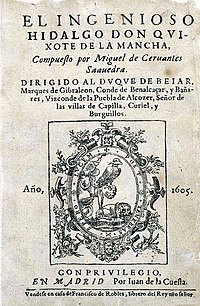Literature
The Spanish Golden Age was a time of great flourishing in poetry, prose and drama.
Cervantes and Don Quixote

Cervantes'
Don Quixote (1605), original title page
Regarded by many as one of the finest works in any language,
El ingenioso hidalgo Don Quixote de la Mancha by
Miguel de Cervantes was
one of the first novels published in Europe; it gave Cervantes a
stature in the Spanish-speaking world comparable to his contemporary
William Shakespeare in English. The novel, like Spain itself, was caught between the
Middle Ages and the modern world. A veteran of the
Battle of Lepanto (1571),
Cervantes had fallen on hard times in the late 1590s and was imprisoned
for debt in 1597, and some believe that during these years he began
work on his best-remembered novel. The first part of the novel was
published in 1605; the second in 1615, a year before the author's
death.
Don Quixote resembled both the medieval, chivalric romances of an earlier time and the novels of the early modern world.
It
parodied classical morality and chivalry, found comedy in knighthood,
and criticized social structures and the perceived madness of Spain's
rigid society. The work has endured to the present day as a landmark
in world literary history, and it was an immediate international hit in
its own time, interpreted variously as
a satirical comedy, social commentary and forbearer of self-referential literature.
Lope de Vega and Spanish drama
A contemporary of Cervantes,
Lope de Vega consolidated the essential genres and structures which would characterize
the Spanish commercial drama, also known as the "Comedia",
throughout the 17th century. While Lope de Vega wrote prose and poetry
as well, he is best remembered for his plays, particularly those
grounded in Spanish history. Like Cervantes, Lope de Vega served with
the Spanish army and was fascinated with the Spanish nobility. In the
hundreds of plays he wrote, with settings ranging from the Biblical
times to legendary Spanish history to classical mythology to his own
time, Lope de Vega frequently took
a comical approach just as Cervantes did, taking a conventional moral play and dressing it up in good humor and cynicism. His stated goal was
to entertain the public, much as Cervantes's was. In bringing
morality, comedy, drama, and popular wit together, Lope de Vega is often compared to his English contemporary Shakespeare. Some have argued that as a social critic, Lope de Vega
attacked, like Cervantes,
many of the ancient institutions of his country - aristocracy, chivalry, and rigid morality, among others.
Lope de Vega and Cervantes represented an alternative artistic
perspective to the religious asceticism of Francisco Zurbarán. Lope de
Vega's
"cloak-and-sword" plays, which mingled intrigue, romance, and comedy together were carried on by his literary successor,
Pedro Calderón de la Barca, in the later seventeenth century. Other well-known playwrights of the period include:
Tirso de Molina;
Agustín Moreto;
Juan Pérez de Montalbán;
Juan Ruiz de Alarcón;
Guillén de Castro and
Antonio Mira de Amescua.
Poetry
Other significant authors
ANSWER THESE QUESTIONS:
1. What Spanish writers are compared to Shakespeare?
2. What is similar between Shakespeare's work and the work of the Spanish playwrights?


